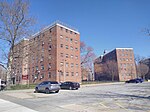Arlington Yard

Arlington Yard is a freight yard located on the North Shore Branch right of way of the Staten Island Railway in Staten Island, New York, United States. It lies west of the former Arlington station, east of Western Avenue, and north of the Staten Island Expressway in the Port Ivory neighborhood. The yard leads into the Travis Branch of the railway, the Howland Hook Container Terminal, and the Arthur Kill Lift Bridge to Elizabeth, New Jersey and the Chemical Coast and is part of the ExpressRail network.The 2007 opening of the Staten Island Transfer Station and the ExpressRail facility, along with the reopening of the Arthur Kills bridge, has reactivated the yard. The use of the Howland Hook Container Terminal to transfer containerized municipal waste from barges to trains, servicing roughly half of New York City's barged trash volume, has added to the rail traffic handled by the yard. (The facility that handles the other half is located directly across Arthur Kill.)
Excerpt from the Wikipedia article Arlington Yard (License: CC BY-SA 3.0, Authors, Images).Arlington Yard
Richmond Terrace, New York Staten Island
Geographical coordinates (GPS) Address Nearby Places Show on map
Geographical coordinates (GPS)
| Latitude | Longitude |
|---|---|
| N 40.6333 ° | E -74.1745 ° |
Address
Mariner's Marsh Park
Richmond Terrace
10303 New York, Staten Island
New York, United States
Open on Google Maps







